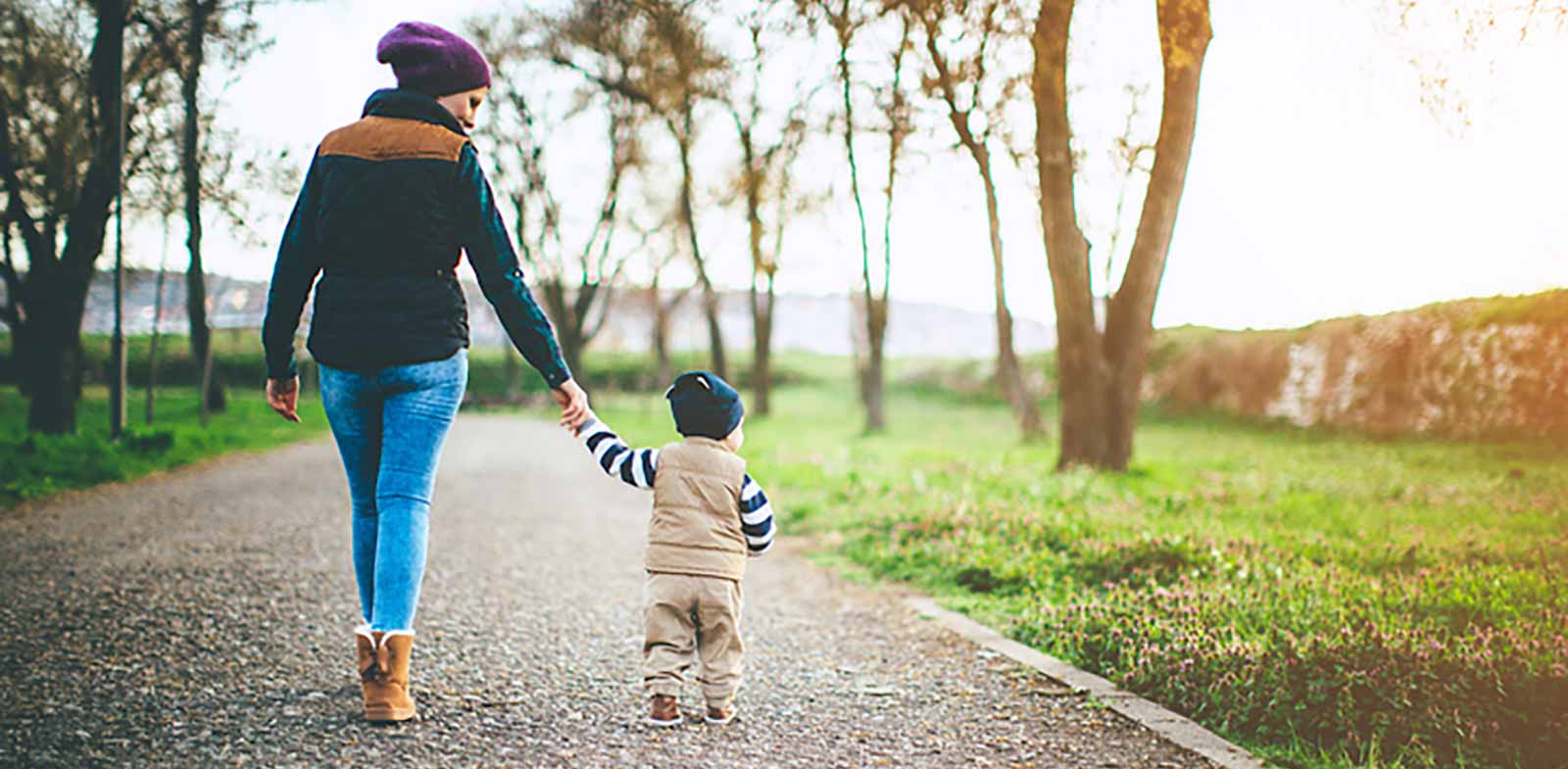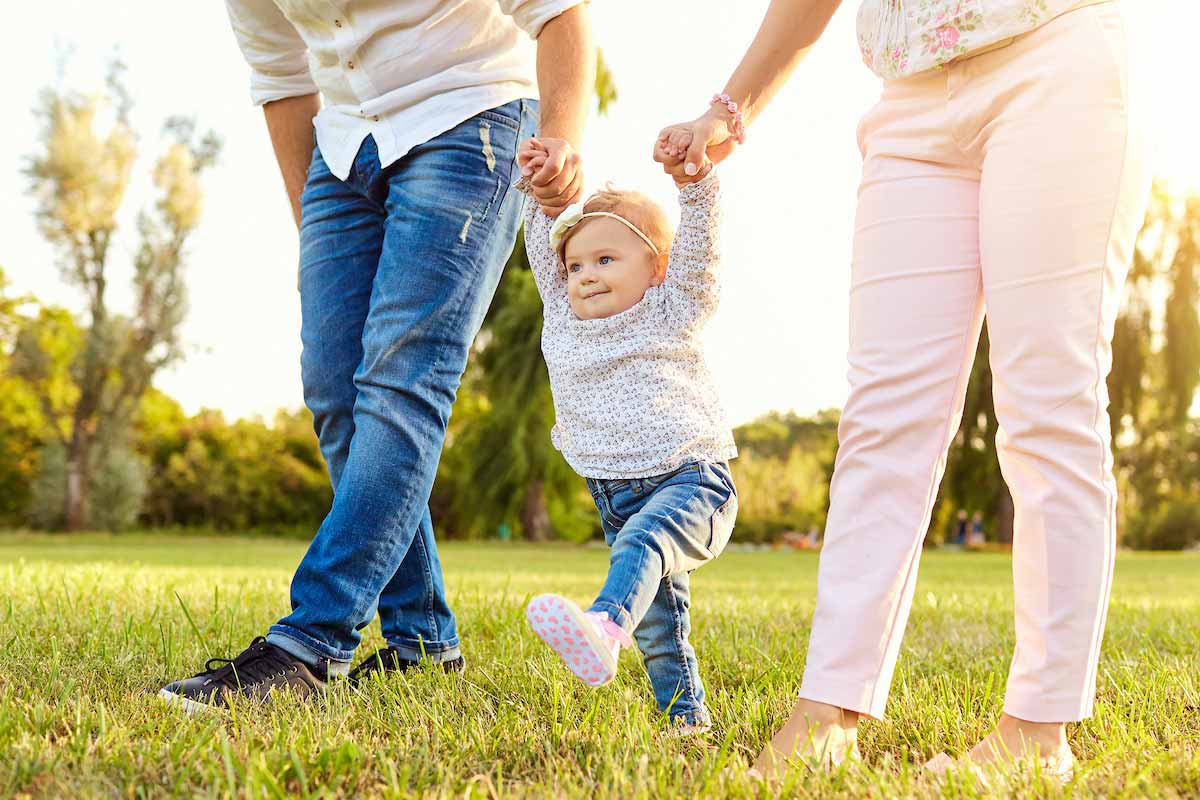A baby’s first few months and years of life are filled with all sorts of new sensations, experiences, and joys. Getting your child outdoors into the fresh air is beneficial to their health and development, while helping them to form lasting impressions and memories of togetherness.

Part of parenting involves introducing your baby to new experiences in their first few years of life. Time outside is especially important, as it gives your child a chance to explore and learn more about the surrounding world. Plus, outdoor play helps benefit a child’s neurological development, gross motor skills, creativity, and is an excellent way to be together as a family.
Since deciding what to do with your little one isn’t always easy, we’ve assembled a list of some of our favorite outdoor activities for infants and toddlers below.
There are lots of fun, sensory things to do with babies outside that will aid in their development and keep them entertained. From a hike in the park to playing with sand, the wide world is indeed full of possibilities.
Use your best judgment when going out for an adventure with your child, gauging the fitness of activities by your child’s age, what they like, their mood, the weather, what gear and supplies you have available, and the time of year. You can always get creative and put your own spin on our ideas below, or incorporate multiple activities into a single outing—like playing tag after a picnic and playing with chalk.
Remember to keep your little one protected from the sun’s UV rays, as infants and toddlers are especially vulnerable to sunburn. Due to the sensitive and rash-prone nature of a baby’s skin, the FDA generally recommends against the use of sunscreen on infants, in favor of other protective measurements.
So make sure your child is dressed appropriately for the weather, temperature, and levels of sunlight. Bring along a change of clothes and any accessories should the weather change—a raincoat, beanie, booties, blanket, extra sunhat, and so on. For storage, your diaper bag or stroller basket should provide ample space.
1. Go Hiking or Walking
From a casual stroll in the park to a hike on local trails, getting out for a walk with your infant or toddler is an excellent way to explore the natural world. Babies can take in the sights, sounds, new smells, and sensations of being outside from the comfort of a stroller or carrier.
For hiking, bringing your baby along in a baby carrier tends to be the best option, as strollers get cumbersome on narrow, rocky trails. Choose a carrier that’s the right fit for your baby’s size and age, distributes their weight evenly, and has the comfort and storage features you prefer. The Chicco SideKick Plus 3-in-1 Carrier is a great choice for outdoor adventures, with multiple carry modes and a “hip-healthy” certification from the International Hip Dysplasia Institute. Besides the convenience, babywearing benefits a child’s intellectual and emotional development. The close contact promotes healthy parent-child bonds while helping you be more attuned to your little one’s needs.
As your child grows, you may switch to a backpack-style carrier. This usually happens around the six-month mark, or when your child has strong head and neck control. Babies can ride in most carriers until around 40 pounds—after that, they’re freer to roam.
And when you’re not hiking? Strollers are a staple of parenting suitable for nature walks on smooth paths and paved surfaces. Choose a lightweight model if you’re looking for portability and ease of use, or select a jogging stroller for unmatched locomotion across mixed terrains. Look for strollers that have a UPF-rated canopy to better protect babies from the sun. And if you’re in the market for a new stroller, check out our stroller buyers’ guide for a full rundown of the different types of strollers and what’s available at Chicco.
Even if your child can walk, it’s wise to bring along the stroller or a carrier if they’re new to foot travel. This gives kids (especially toddlers) the option to walk or ride, depending on how they’re feeling. Keep in mind that hiking with a baby doesn’t mean scaling steep peaks and tough terrain.
2. Have a Picnic
Spread out a blanket on the lawn and have a picnic with your child. Picnics are a great way to spend quality time with your baby, whether they’re a few months or a few years old. Set up a picnic in the comfort of your own backyard or head over to a nearby park. This is especially fun with infants, as you can sit them up on a blanket, let them crawl around, feel the grass, listen to the birds, and so on.
Engage your child’s inquisitive nature by naming objects in the environment, or pointing out a particular sound or sensation. For little ones working toward taking their first steps, the soft grass and blanket of a picnic provide a welcoming environment to practice walking.
And of course, don’t forget to bring along sippy cups, a cloth towel, bibs, and any other feeding accessories you’ll need for the picnic, depending on the age of your child. You can even pack a few books for storytime in the shade.

3. Play With Bubbles and Other Toys
Get outside for playtime and give your little one an opportunity to feel the grass or sand underfoot, marvel at bugs, and be silly just playing around. The best outdoor activities for infants and toddlers give kids the freedom to be themselves while developing their physical and mental dexterity.
Babies love blowing and popping bubbles, which helps to develop hand-eye coordination, spatial awareness, balance, and visual tracking skills. Plus, bubbles are inexpensive to purchase and easy for children to use with their parents in a variety of outdoor settings.
Play in your backyard, at a nearby park, on the beach, and wherever you see fit. Use this time to play with other toys as well, like a ball or sandbox toys.
4. Have a Scavenger Hunt
Engage your child’s imagination with a scavenger hunt. Keep it simple, making it easy yet rewarding for your child to find whatever you’ve hidden in the yard. Give them hints and small prizes to keep them engaged and their minds working, using context clues in a process similar to solving a basic puzzle. Note that in terms of outdoor activities for infants versus toddlers, this one will be much easier once your child can walk.
5. Explore Gardening
Gardening is a great hands-on outdoor activity for babies of all ages, especially those who are a little older and have had time to develop sharper gross motor skills. (That said, gardening still works as a fun outdoor activity for toddlers, but may require more guidance.)
Plant seeds together in your backyard or in a pot, from flowers to fruits and vegetables. Kids can get their hands dirty and have fun feeling around in the warm soil. Keep it simple and avoid safety hazards like sharp clippers—and don’t forget a hat for shade, sunglasses, and other outdoor protective gear.
Over time, your baby can watch as the plants mature and bloom. Let your child help with the watering and other small tasks, like adding more soil and making sure the seeds are getting enough sunlight. Gardening also provides your child with positive connections to nature and memories of time spent together.

6. Have a Dance Party
Let your child be silly and express themselves by having a dance party! This helps with your little one’s coordination and ability to relate to music. For infants, you can help them wave their arms and wiggle their feet to the music while they sit, while older babies can practice standing and dancing upright. Plus, dance parties are a fun, simple, and easy activity requiring no toys or equipment beyond a music player and an active imagination.
7. Practice Walking
Rounding out our list of outdoor activities for babies is taking time outside to practice walking. Wobbly tots are prone to falling over, falling backward, stumbling, and being adorable in the process. When helping them learn to walk outside, stick to soft surfaces, like grassy areas, a picnic blanket, or a beach towel. Having two people involved also helps, so you can hold baby’s hands on either side for reassurance as they try out this unusual activity so alien to their tiny legs.
Children bursting with energy need an outlet and a way to express themselves. When the weather is nice, embrace the opportunity to take your baby out into the open air, rather than having them crawl or run around inside. Getting kids outside also helps them to develop good habits by teaching responsibility, instilling confidence, and encouraging creativity.
The great outdoors is a vital part of growing up, even if, as a busy parent, you don’t have tons of free time for taking baby on big adventures or trips far away. Even 30 to 45 minutes in the yard before dusk makes a difference.
To make the most of your time outside with your young ones:
- Choose sensory activities and outings, especially things that are tactile and interactive (like finger painting, listening to music, or playing with bubbles).
- Encourage creativity, independence, and participation to further strengthen the bond between parent and child.
- Mix it up with a blend of active and passive activities depending on your child’s age and energy levels.
- Welcome spontaneity. If you planned to have storytime but your child wants to run in circles, go for it!
- Engage your child’s imagination! Bring chalk on a walk for impromptu sidewalk art, play pretend, act out characters from a book or show they like, and so on.
- When hiking, choose locations that will be low-risk and won’t strand you too far from your car in case of inclement weather or an emergency.
- As you walk or hike, be on the lookout for flat areas or small rest spots where your toddler can safely explore and do things like look at the ground in close detail. This is a good opportunity for them to get their feet on the ground, as toddlers will get antsy being in the carrier or stroller for extended time periods.
- Bring the right supplies—plenty of water, healthy snacks (or baby formula), a change of clothes for baby, an umbrella, and any gear like a diaper bag and carrier.
As a parent, it’s important to be flexible and considerate of your child’s needs. Talk to them. See what they’d like to do during a sunny afternoon and how they want to spend time, making it exciting and adventurous.
Now that we’ve looked at some ideas for what to do with your baby outside, from infancy onward, it’s time to go explore! We hope these outdoor activities for infants and toddlers will be useful and inspire you on your parenting journey. Whether you’re a new parent or you’re welcoming a new baby to your growing family, it’s important to stay prepared with the right baby gear. Explore Chicco strollers for your next walk in the park, car seats for the ride over, and travel systems for the best of both worlds.
